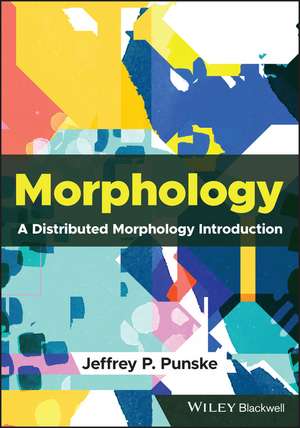Morphology – A Distributed Morphology Introduction
Autor JP Punskeen Limba Engleză Paperback – 5 noi 2023
Preț: 314.97 lei
Nou
Puncte Express: 472
Preț estimativ în valută:
60.32€ • 62.15$ • 50.53£
60.32€ • 62.15$ • 50.53£
Carte disponibilă
Livrare economică 03-17 februarie
Livrare express 17-23 ianuarie pentru 41.16 lei
Preluare comenzi: 021 569.72.76
Specificații
ISBN-13: 9781119667834
ISBN-10: 1119667836
Pagini: 304
Dimensiuni: 183 x 252 x 18 mm
Greutate: 0.59 kg
Editura: Wiley
Locul publicării:Hoboken, United States
ISBN-10: 1119667836
Pagini: 304
Dimensiuni: 183 x 252 x 18 mm
Greutate: 0.59 kg
Editura: Wiley
Locul publicării:Hoboken, United States
Cuprins
Author's Note xi Note to Instructors xii List of Abbreviations xiii Part 1 Understanding Morphology 1 1 Defining Morphology 3 0. Preliminaries 3 1. Wordhood 4 2. Doing Morphology 6 3. Theories of Morphology 11 4. Conclusions 13 5. Organization of This book 13 Concepts, Ideas, Rules, and Principles Introduced in This Chapter 13 Further Reading 15 General Problem Sets 16 Challenge Problem Sets 19 2 Types of Morphemes 20 0. Preliminaries 20 1. General Types of Morphemes 21 2. Morphological Universals 26 3. Category 27 4. Glossing Conventions 32 5. The Morphological Process 34 6. Conclusions 37 Concepts, Ideas, Rules and Principles Introduced in This Chapter 38 Further Reading 39 General Problem Sets 40 Challenge Problem Sets 43 3 Basic Morphology Analysis 44 0. Preliminaries 44 1. Sources of Data 45 2. Approaching the Data 46 3. Basic Morphological Analysis 50 4. Conclusions 56 Concepts, Ideas, Rules, and Principles Introduced in This Chapter 56 Further Reading 57 General Problem Sets 57 Challenge Problem Sets 59 4 Morphophonology 60 0. Preliminaries 60 1. Defining Phonology 60 2. Basic Concepts in Phonology 61 3. Defining Morphophonology 74 4. Conclusions 78 Concepts, Ideas, Rules, and Principles Introduced in This Chapter 79 Further Reading 80 General Problem Sets 81 Challenge Problem Sets 83 5 Advanced Morphological Analysis 85 0. Preliminaries 85 1 Syllable Structure 86 2 Markedness 91 3 Dissimilation 93 4 Pivots: Reduplication and Infixation 95 5 Conclusions 98 Concepts, Ideas, Rules and Principles Introduced in This Chapter 99 General Problem Sets 100 Further Reading 99 Challenge Problem Sets 105 Part 2 Building a Framework 107 6 Features 109 0. Preliminaries 109 1. Features and the Subset Principle 110 2. Impoverishment 118 3. Defining and Constraining Features 120 4. Doing Featural Analysis 126 5. Conclusions 132 Concepts, Ideas, Rules, and Principles Introduced in This Chapter 133 Further Reading 135 General Problem Sets 135 Challenge Problem Sets 137 Contents ix 7 Morphology and Syntax 143 0. Preliminaries 143 1. Syntax 144 2. A Generative Lexicon and the Mirror Principle 146 3. Morphology as Syntax 147 4. Syntactic Operations 156 5. Post-Syntactic Morphological Operations 159 6. Conclusions 169 Concepts, Ideas, Rules and Principles Introduced in This Chapter 169 Further Reading 171 General Problem Sets 171 Challenge Problem Sets 173 8 Lexical Semantics 176 0. Preliminaries 176 1. Lexical Semantics and Structure 176 2. Argument Structure 183 3. Conclusions 185 Concepts, Ideas, Rules and Principles Introduced in This Chapter 186 Further Reading 186 General Problem Sets 187 Challenge Problem Sets 187 9 Root and Pattern Morphology 190 0 Preliminaries 190 1 A Tiered Approach 192 2 Root and Pattern in the Syntax 194 3 Conclusions 197 Concepts, Ideas, Rules, and Principles Introduced in This Chapter 198 Further Reading 198 General Problem Sets 198 Challenge Problem Sets 200 10 Incorporation and Compounding 201 0. Preliminaries 201 1. Incorporation 202 2. Compounding 204 3. Conclusions 207 Concepts, Ideas, Rules and Principles Introduced in This Chapter 207 Further Reading 207 General Problem Sets 208 Challenge Problem Sets 210 11 Non-compositionality 211 0. Preliminaries 211 1. Defining Non-Compositionality 212 2. Deriving Non-Compositionality 214 3. Expanding the Model 216 4. Conclusions 220 Concepts, Ideas, Rules, and Principles Introduced in This Chapter 220 Further Reading 220 General Problem Sets 221 Challenge Problem Sets 223 12 Concluding Remarks 224 0. Distributed Morphology and Linguistic Theory 224 Final Model of Distributed Morphology 227 Problems and Discussion 228 Further Reading 230 IPA Quick Guide 240 Language Glossary 242 Glossary 266 References 277 Index 287
